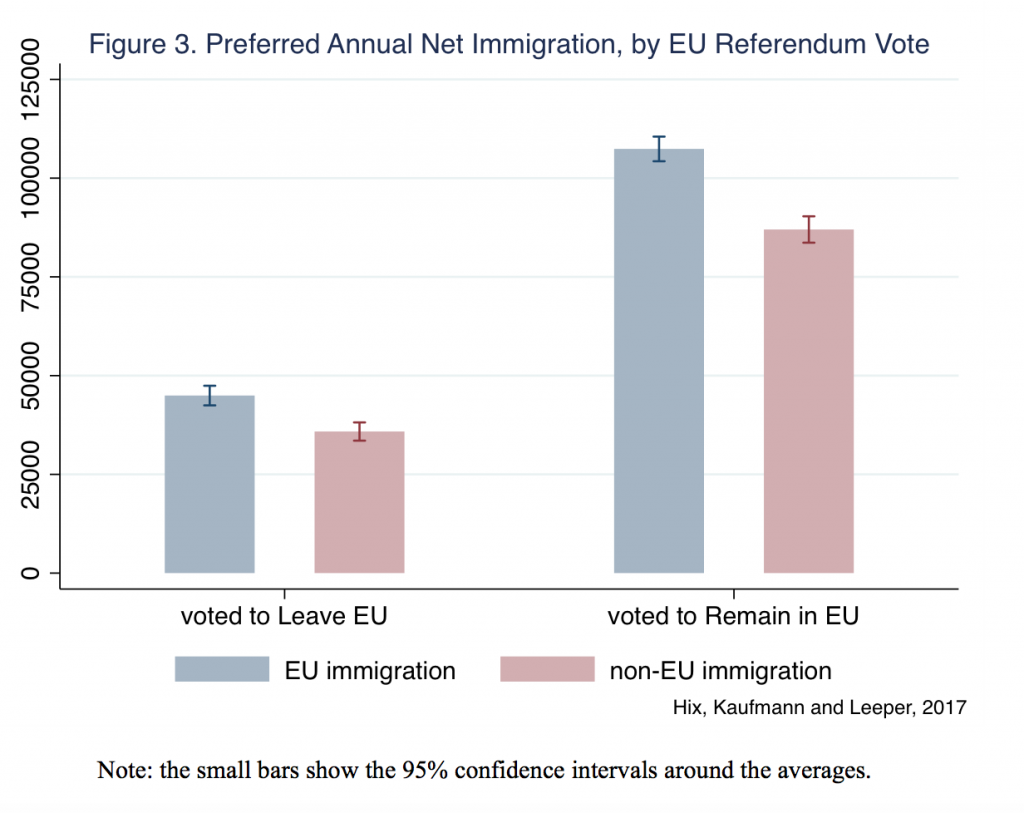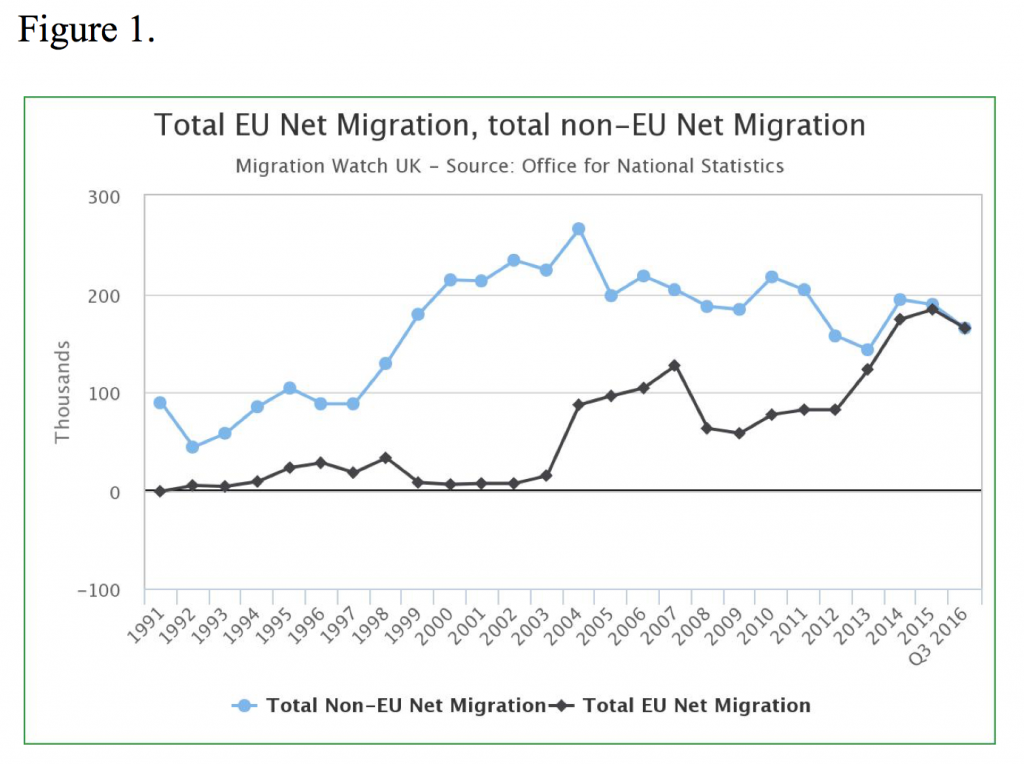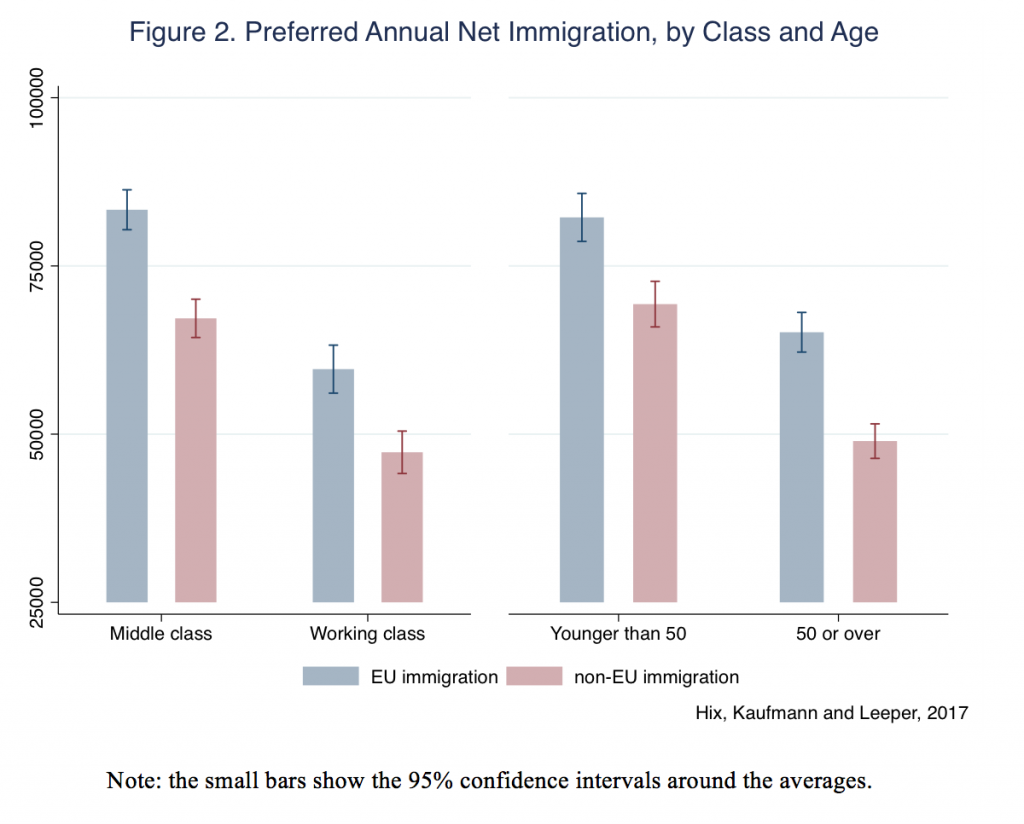

 Despite the argument that Brexit was about sovereignty and only secondarily about immigration, new data suggest otherwise. Simon Hix, Eric Kaufmann, and Thomas J. Leeper show the importance of reducing immigration levels – especially from outside the EU – to British voters.
Despite the argument that Brexit was about sovereignty and only secondarily about immigration, new data suggest otherwise. Simon Hix, Eric Kaufmann, and Thomas J. Leeper show the importance of reducing immigration levels – especially from outside the EU – to British voters.
Brexit leaders such as Boris Johnson have maintained a narrative that sovereignty, not immigration, was the key motivation behind the Leave vote. Keen to distance themselves from charges of xenophobia, Vote Leave worked hard to dispel the notion that their cause was powered by generalised anti-immigration sentiment. Where immigration was mentioned, the issue, it was claimed, was not numbers but control and fairness. Why should unskilled East Europeans get in ahead of qualified South Asians? Leave leaders took pains to reach out to Britain’s Asian community: MPs Gisela Stuart and Priti Patel spoke of how hard it was for those from the Indian subcontinent to get visas while EU migrants were able to simply walk in. A significant minority of Asian voters, including the main curry chef association, returned the favour by backing Brexit.
Yet academic research raises questions over this interpretation. First of all, immigration was key. Using survey data, Harold Clarke, Paul Whiteley, and Matthew Goodwin show that immigration is by far the strongest predictor of a Leave vote, and anti-immigration folk were more motivated to show up at the polls than others. Meanwhile, Geoffrey Evans and Jon Mellon find that UKIP and Vote Leave were able to successfully link the immigration issue, which voters cared about, to the EU question, which they didn’t, generating the electricity needed to put Leave over the top.
Second, and more surprising, is concern over non-European immigration. The problem of unrestricted low-skill European immigration was repeatedly flagged during the campaign, so many assume people voted Leave because they were primarily exercised by the issue of East European immigration. This turns out not to be the case.
We tend to make emotional decisions and rationalise these to ourselves after the fact. American social psychologist Jon Haidt calls our emotions the ‘elephant’ and our cognition the ‘rider’. Daniel Kahneman and Amos Tversky prefer ‘fast’ and ‘slow’ thinking as the metaphor. Either way, our research shows that immigration in general – notably non-EU immigration – is the fast-thinking elephant behind the Leave vote.
Over the past two decades, non-European immigration has usually exceeded European immigration as figure 1 shows. The share of non-European origin in the population of England and Wales doubled between 2001 and 2011. Yet openly appealing to anti-Asian or anti-African immigration sentiment was tricky due to its racial connotations. As Labour MP Frank Field relates: ‘The truth is, I wasn’t brave enough to raise it [immigration] as an issue – though I thought it was an issue for yonks – until we were talking about white people coming in. And even then the anger that this was racist was something one had to face.’
In order to assess the importance of non-European immigration we conducted a survey of 3,636 UK residents through YouGov’s online panel between 26 April and 3 May 2017. We asked respondents separate questions about EU and non-EU immigration, asking them to indicate their preferred level of net immigration of each group on a sliding scale from 0 (meaning no net immigration) to 165,000 (the then-current levels for each world region). (The full question is included at the end of this post).
What’s striking – and no one is talking about – is that British voters prefer EU to non-EU migrants: the blue bars representing desired levels of European immigration are higher than the red bars for preferred levels of non-European immigration among all British voters. This pattern of preferring immigrants from inside the EU to those from outside holds across all social groups in our data. For example, figure 2 shows the patterns by social class and age. Middle class people (in ABC1 social grades) prefer more net immigration than working class people (in C2DE social grades), but both groups want fewer non-EU than EU immigrants. Similarly, younger people prefer more net immigration than older people, but, again, all want fewer non-EU than EU immigrants.
The same pattern holds for Leavers and Remainers, as shown in figure 3. But Leavers are much more motivated by the immigration issue than Remainers and seek far lower numbers. As figure 3 reveals, the average Leaver in our data wants non-European net migration reduced from about 165,000 in 2016 to 36,000. In other words, they are calling for a bigger cut in non-EU than EU inflows.
 These findings echo those of a recent study showing that the increase in non-European (BAME) respondents in a White British person’s local area in the 2000s was a somewhat stronger predictor of their support for UKIP than the increase in local European population. This suggests that in the wake of the 2015 Migrant Crisis, the threat of unchecked non-European immigration, alluded to in Nigel Farage’s controversial ‘breaking point’ poster, may have motivated some Leave voters. A keen sense of these sentiments may also have informed the government’s recent decision to increase the Immigration Skills Charge and raise earnings thresholds for those seeking to sponsor relatives from outside the EU.
These findings echo those of a recent study showing that the increase in non-European (BAME) respondents in a White British person’s local area in the 2000s was a somewhat stronger predictor of their support for UKIP than the increase in local European population. This suggests that in the wake of the 2015 Migrant Crisis, the threat of unchecked non-European immigration, alluded to in Nigel Farage’s controversial ‘breaking point’ poster, may have motivated some Leave voters. A keen sense of these sentiments may also have informed the government’s recent decision to increase the Immigration Skills Charge and raise earnings thresholds for those seeking to sponsor relatives from outside the EU.
Despite Vote Leave’s insistence that Brexit was mainly about sovereignty and secondarily about concerns over the unfair access to Britain enjoyed by EU migrants, our results suggest otherwise. These are the post-hoc rationalisations of a rider whose anti-immigration elephant is firmly in control.
______
 Simon Hix is Harold Laski Professor of Political Science at the LSE.
Simon Hix is Harold Laski Professor of Political Science at the LSE.
 Eric Kaufmann is Professor of Politics at Birkbeck College, University of London.
Eric Kaufmann is Professor of Politics at Birkbeck College, University of London.
 Thomas J. Leeper is Assistant Professor in Political Behaviour at the LSE.
Thomas J. Leeper is Assistant Professor in Political Behaviour at the LSE.
According to government statistics, about 3 million European Union citizens and 5 million non-EU citizens live in the United Kingdom. Annually, net migration from the EU is 165,000 and net migration from elsewhere (mainly Asia, Africa and the Middle East) is also 165,000. This means that 330,000 more people move to the UK each year than leave.
We would like to know how much net migration you would prefer to have from the EU and from elsewhere. Please indicate your preferences as a number: choosing “0” would mean cutting net migration to zero, while choosing “165,000” means keeping levels as they are currently.
How much net migration should there be from the EU?
How much net migration should there be from outside the EU?










A very good read. between 1979 and 1997 the Conservative government had an immigration policy of a rough goal of zero net migration. It was sanctioned in 5 general elections. After 1997, the Labour government overturned the policy without any democratic reference as the policy change was not stated and neither was the British electorate informed or consulted. in other words, no democratic consent. Under Labour the vast majority of net migrants were non EU. Also, in the past ten years the non-EU net migration rate has been overestimated by double due to to non-EU students not being counted out adequately enough. The government knows and is too embarrassed to admit it. The EU net migration has been under counted
Apologies for commenting at such a late point. The article and research is useful. From a wider perspective, the emphasis on immigration in UK politics is dismaying. I find the rise of UKIP, Brexit Party, EDL, Robinson, etc., indicates quite a large current of underlying racism. People who support these parties/individuals are welcome to do so but the kind of society they want is not one I want to live in – I would leave the UK to get away from this kind of politics.
This is a brilliant article! It is indeed strange how people have become so racist. During the days of apartheid it was open. A white man could shout out obscenities from his window at the black man passing below. Today’s neo-apartheid has taken such a subtle twist.
I am from South Asia and have spent 18 years working for Fortune 100 companies, helping them optimise their systems and applications and have successfully contributed to their success and continued growth, saved them millions of dollars and added huge value to their business. All these were in western Europe, Asia and the US but NOT in the UK.
In the UK, I was surprised to see 30-40 year old systems still being used in banks and financial institutions! Some even bought stuff from eBay to replace their old broken down hardware just because the companies that used to make them no longer exist! No wonder there are banks that lose their data or even can’t function for more than a week! I shudder at the thought of what is in store! ALL of them use cheap expertise from Indian companies to hang on to their dear lives!
The NHS is in shambles! Everybody in the UK knows that! Why on Earth can’t you get an appointment with your GP when you need to?! Even in a third world country, you can see a doctor much faster and don’t have to wait for hours in a room clogged with the sick and the wounded waiting to see the light at the end of the tunnel! Well, you can only see a doctor if you HAVE one! Grow up ye Brits! Them doctors are all busy keeping the royals and the super rich fit and healthy, they have no time for ye poor subjects! And of course, none want to have a brown/black skinned Indian/Pakistani/African with a funny accent to get you out of your pain! Oh no, you don’t! You have your pride to look after!!! Keep moaning and groaning ye groan up Brits!
And how easy it is for a ‘non-EU’ to get a visit visa? A few days and 80-90£!
What about work visa for a non-EU? A couple of months and 1000£ per applicant + IHS fees of 400£ per person per year ONLY!
So for a family of four non-EU to visit: ~400£
To work on Tier-2 General: ~ 14000£ for 5 years!
The IHS fees was 200 and is increased to fund the NHS!!!
SHAME SHAME SHAME!!!
After spending centuries looting the wealth of these countries, reducing all of them to third world countries and then calling them ‘commonwealth’ (as if they owed Britain anything), Britain has successfully outdone itself to keep these highly skilled people out of the country for fear they will have their vengeance!
That is some brain you got there!!!
Interesting, but please don’t advertise Migration Watch by using their charts- there are plenty of less contentious sources
Then there are those who voted to leave the EU for many reasons, one being that immigration rules have been tightened for people from Commonwealth countries because the UK cannot simply take everyone from everywhere.
This ended (or created difficulty) for immigration from countries that the UK does have shared history with, where most people already speak English, know who our Queen is, & have family in the UK. This was not the EU’s fault, but a line must be drawn somewhere. It was drawn where Brits wanting to marry NON-EU spouses, & at the family reunion, from Non-EU states.
Brits with Non-EU spouses had to jump through hoops & spend loads to have their family live with them when NON-EU people could accompany their EU family member with no charge. I think it risky to underestimate the role that Commonwealth resident votes played in the referendum. Farmers in Zim (descendants of Brit families) were not welcome despite the risk to their lives. The CW vote might be hard to measure as many have become British Citizens, but I am certain it made an impact.
If you look at the greenbelt and the asphalt urbanization you can soon see that urbanization is very tiny in comparison. Immigration will continue because we cannot prevent it. A leopard cannot change it’s spots. Would you have us breathe methane instead of oxygen? Denying our evolutionary identity is more than foolish. Try reading that cover article in New Scientist and then let’s discuss it rationally.
Our government has chosen not to use powers we presently have ,under EU Directive 2004/38/EC, to put restrictions on EU citizens entry, as most other European countries do. We have complete powers over non-EU entry. Immigration is already under our control. If immigration is the main concern, Brexit is built on a non issue.
In the article sovereignty and immigration control are treated as two separate issues. Yet demands for a nation to have control over its borders are also demands for sovereignty. For a sovereign nation borders & immigration should be subject to democratic control. That holds true regardless of whether you want immigration levels cut or increased.
The EU’s figures (EU barometer) indicate that UK attitudes are around average within the EU regarding ‘positivity’ towards inwards EU migration, and for non EU migration UK public opinion is ranked near the top on ‘positivity’. If the authors are arguing that Brexit harnessed anti-immigration sentiment, then we should look at how the immigration debate is playing in France, Holland and Austria, where far right candidates are a part of the mainstream in a way they are not here.
Better prospects lie in people having a more direct say on their country’s immigration policy, as they will in the UK after Brexit. The arguments for greater openness and tolerance will have to be a more direct part of democratic, sovereign politics and less the remit of a technocratic EU. That is the reality now, and one that poses both challenges but also new possibilities for arguing for a more democratic, tolerant and open future.
“How much net migration should there be from the EU?
How much net migration should there be from outside the EU?”
This is just part of the story. There are many reasons for voting for Leave. This is but one.
It is laughable that there was no debate. There was no mention of immigration/migration in the absent debate.
Mobile people voted Remain. Non-mobile people voted Leave.
I contacted everyone involved in the campaign on both sides as well as the government and informed them of the above and also of the missing information and facts about migration/immigration as found in the cover article for the New Scientist for 9 April 2016. Obviously and naturally, I was totally 100% ignored.
The delusional nation is in terminal denial, this is clear. Xenophobic chauvinism and bigotry controls this nation. Education is absent if not extremely poor. Prejudice and racism exists everywhere within and without the EU immigrants. Refugees don’t count and are of no concern to this nation. Germany understands the infinite value of immigration. They know the contents of the New Scientist article very well indeed. Germany’s economy will flourish because of their openness as will Sweden. The failure of the government and society of Britain to accommodate immigration is the reason for any problems. People go where they are welcome and can prosper, hence the current exodus because of Brexit. The abject poverty about to befall the UK will be permanent as the fact of its irrelevance as a tiny, worthless nation in a world that embraces progress and the future. I advise anyone who wants to seriously learn about the importance of immigration to read the article mentioned above. Welcome to the new Britain! Cheers and buckle up for a fun ride.
Mozartsbum – that’s your educated, unbiased and considered opinion, is it?
Mozartsbum wrote:
“Germany understands the infinite value of immigration. They know the contents of the New Scientist article very well indeed. Germany’s economy will flourish because of their openness …”
Then there’s Christopher Caldwell from his 2009 book _Reflections on the Revolution in Europe: Islam, Immigration, and the West_:
“One of the amazing statistics in the history of European immigration is that the number of foreign residents in Germany rose steadily between 1971 and 2000 — from 3 million to about 7.5 million — but the number of employed foreigners in the workforce did not budge. It stayed rock steady at roughly 2 million people. In 1973, 65 percent of German immigrants were in the workforce; in 1983, a decade later, only 38 percent were.” [p. 49]
“Had Europeans realized, when immigration from Turkey, Morocco, Algeria, and elsewhere began in the 1950s and 1960s, that there would be thousands of mosques across Europe half a century later, they would never have permitted it. European tolerance of other cultures was sincere, particularly among the elites, but not even they anticipated that such tolerance would mean the establishment, enrichment, and steady spread of a foreign religion on European soil. In exchange for minor economic returns of extremely short duration, Europe replanted the seeds of a threat that had taken centuries of patience and violence to overcome — interreligious discord, both domestic and international.” [p. 111]
Caldwell from a current article in The Weekly Standard:
“Like many countries in the modern West, Germany needs every penny it can spare to buy social peace, particularly since it must now house and police more than a million mostly nonworking young men newly arrived from the Middle East.”
http://www.weeklystandard.com/print/merkel-makes-an-enemy/article/2008317
Back to Mozartsbum. There’s nothing that has **infinite** value. And, in fact, the value of immigration to Germany and the rest of the West is **less than zero** — it’s negative. It’s a detriment to those societies’ futures as livable First World-countries.
You’re right Paul, I’m sorry for using such an exaggerated word as “infinite”. However, in comparing Germany to Britain, my work experience in Germany was heavenly. Perhaps it’s due to several factors not only immigration from all the world not only Islamic immigration. As a newly hired musician in a German symphonic organization I was paid a starting salary larger than the leader of any British orchestra. I had the choice of deducting the 10% to the church, which I did and gave myself a 10% rise. The society seemed well integrated and the standard of living was at least as good as anywhere else. Immigration plays a major part in growing the economy. Sadly, Britain does not understand this and so by reducing immigration and alienating all foreigners will shrink British society in every way thus guaranteeing that Britain remains an irrelevant country until it becomes a failed state as the Brexiteers want. I’m enjoying the curiosity of observing a country committing suicide. Cheers
PS. I do recommend reading the April 9, 2016 New Scientist cover article on immigration. It’s very enlightening. Of course, if you’re a Brexiteer you won’t like it. Cheers
Don’t people like you get it it is about reducing immigration not stopping it !the current levels of a net increase of over 300000 is madness it should be reduced to match those who leave so we will still be letting in plenty of immigrants just half what we are now! Do you feel there is no need to limit but keep adding and growing until the whole country is covered in tarmac and concrete! Reduce immigration to match those who leave net if 0! 200.000 leave 200.000!as it is about 300.000 leave but over 700.000 come in!and you say people like me need to be educated! It’s obviously people like you you need the Education don’t you care about the increased in traffic houses built on Greenbelt!food prices going up to feed all the extra people !do you think this increasing population can go on forever? What will you be thinking if Britain reaches 100 million? you must be very short sighted!
In fact, from our origins in Africa we’ve conquered the world by migrating. Can modern immigration really be a crisis? Emotion says “yes!” but the BRAIN says “NO WAY JOSÉ!” Looking at the facts frightens people who make decisions and vote with their emotions instead of their brains, so no one uses their brains, hence we have destroyed the UK by our emotional boneheaded Brexit. Cheers and enjoy the cliff fall. It’s only the last 2 inches to worry about.